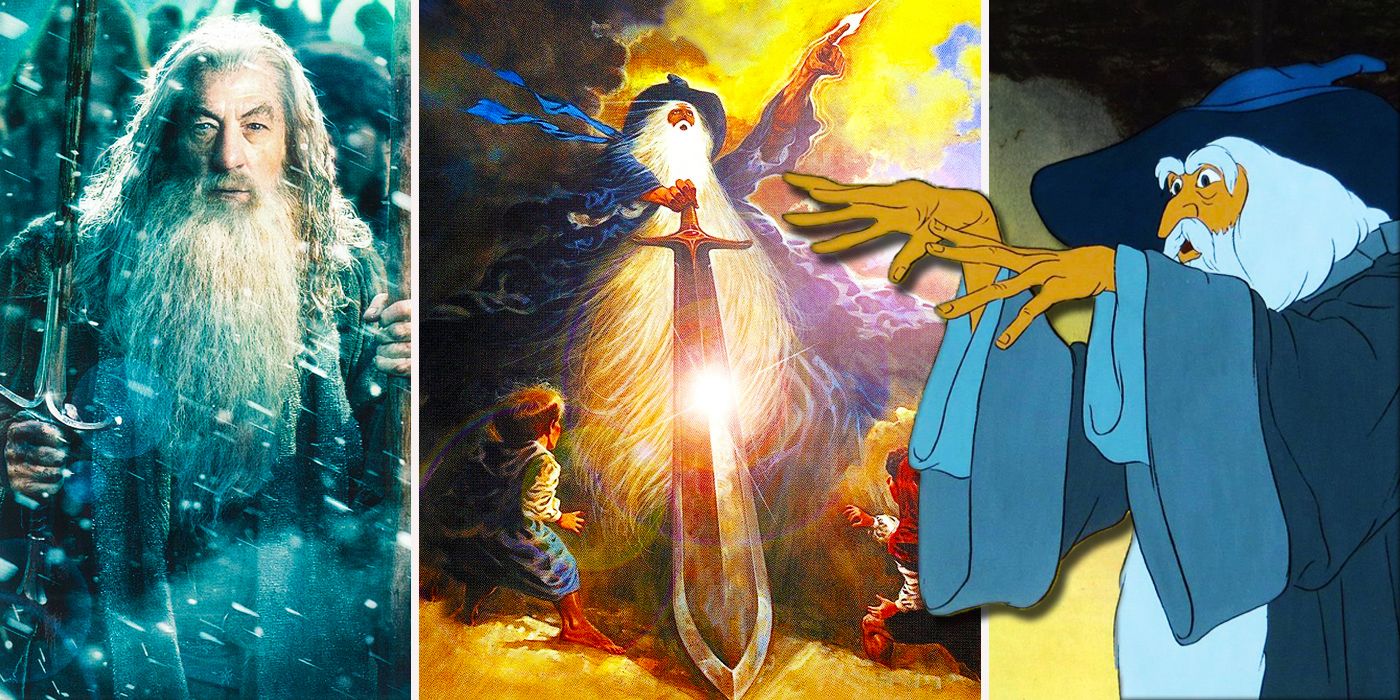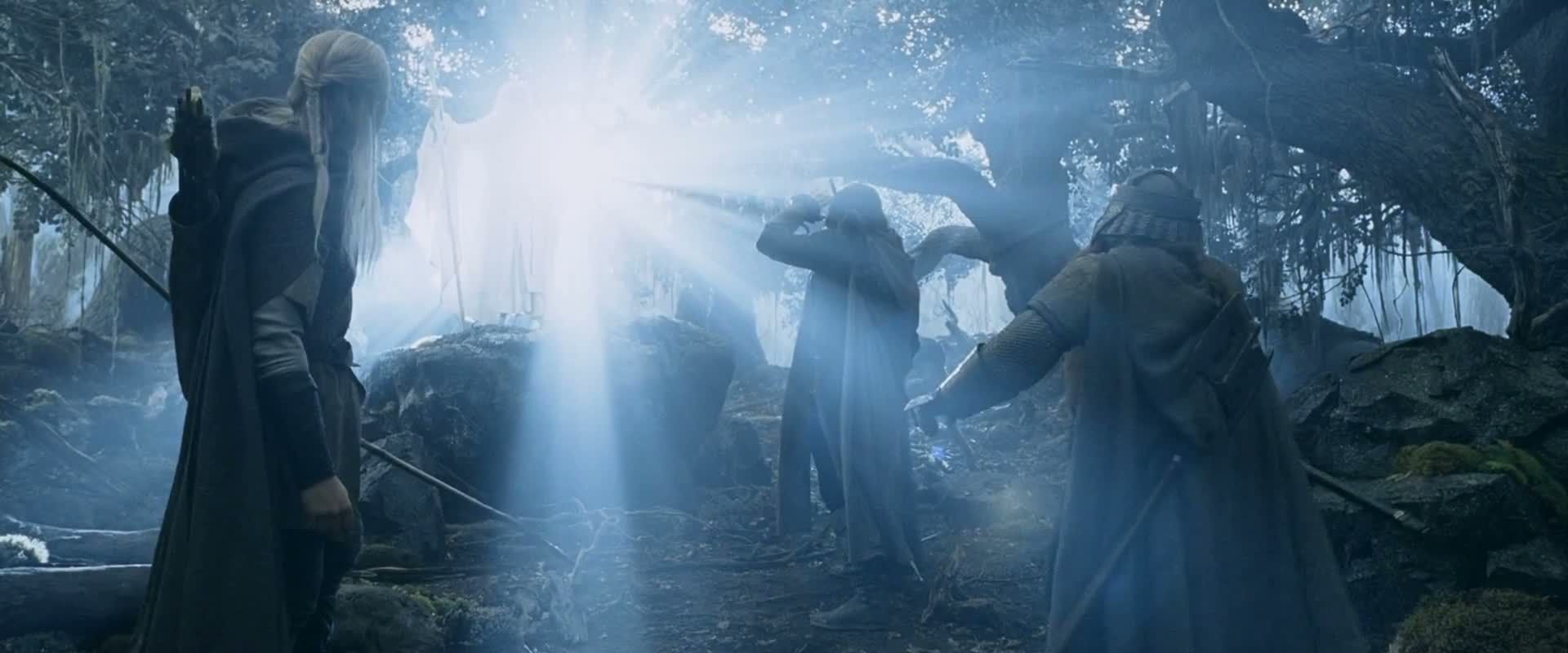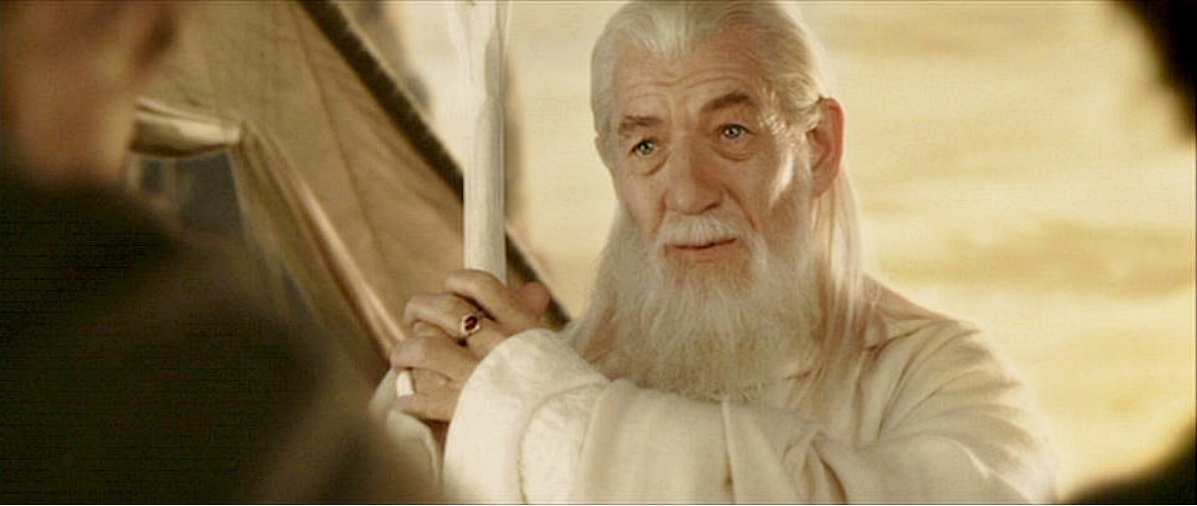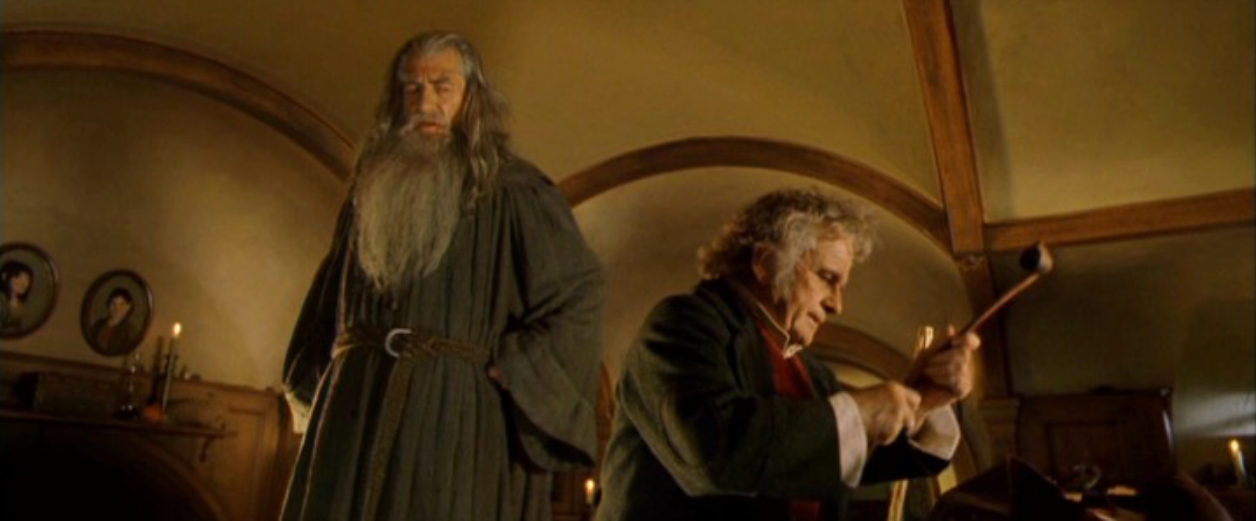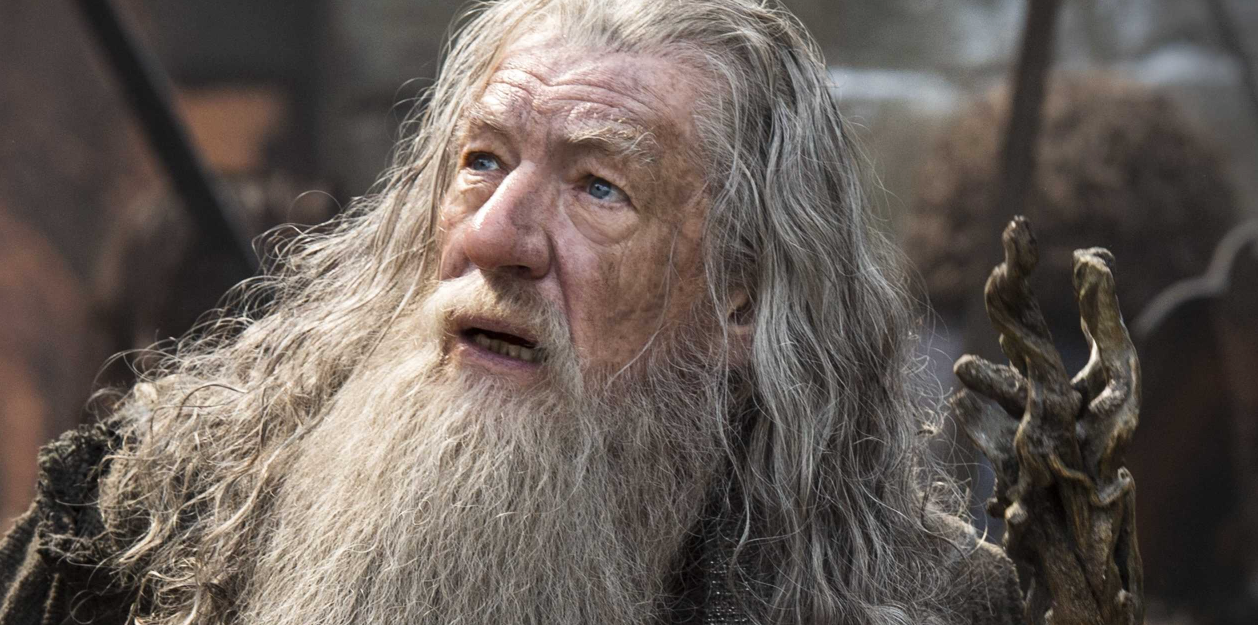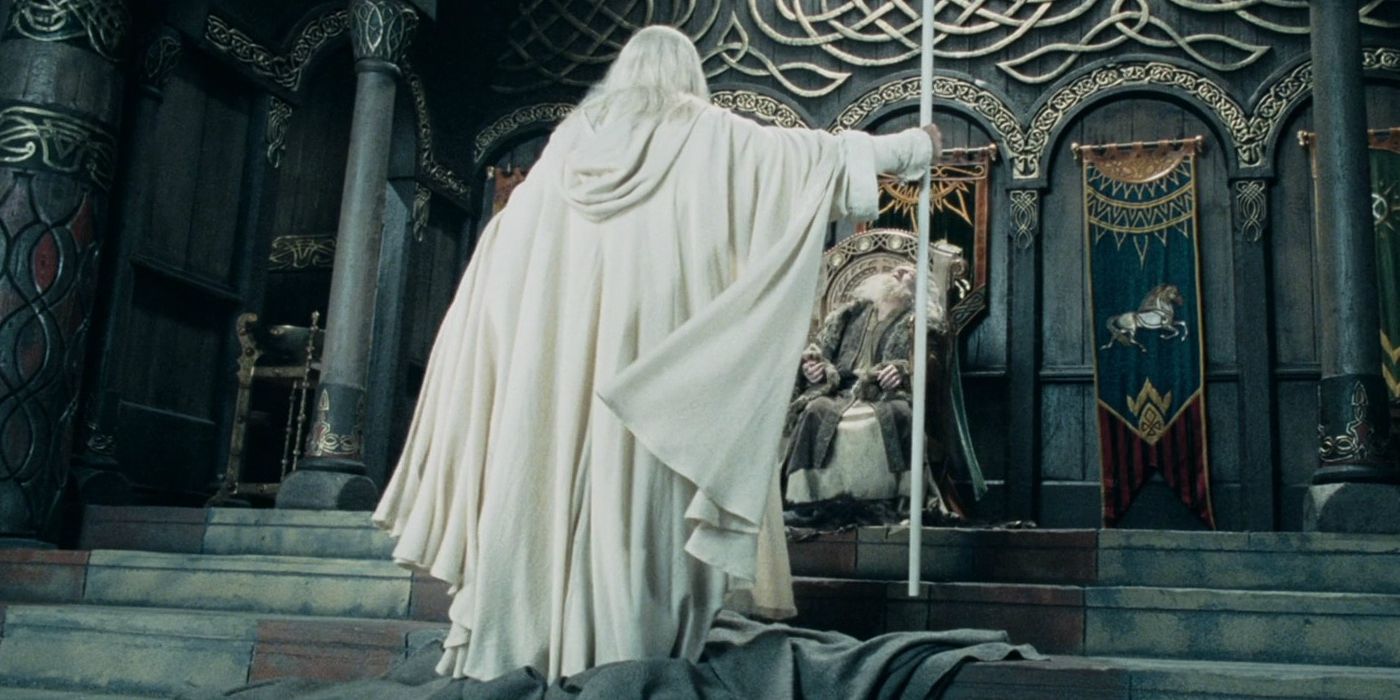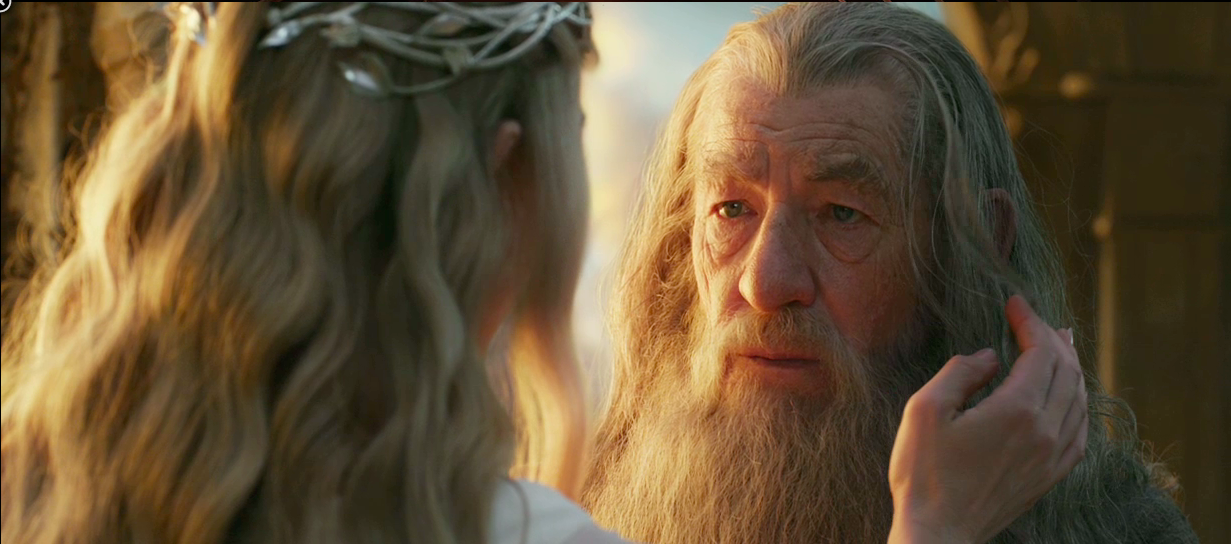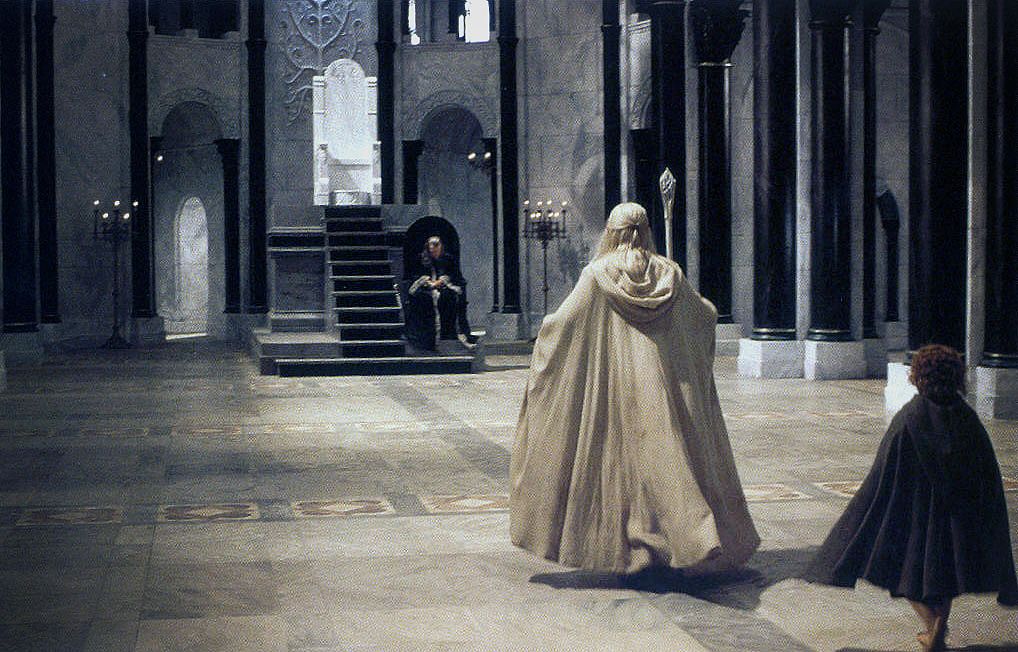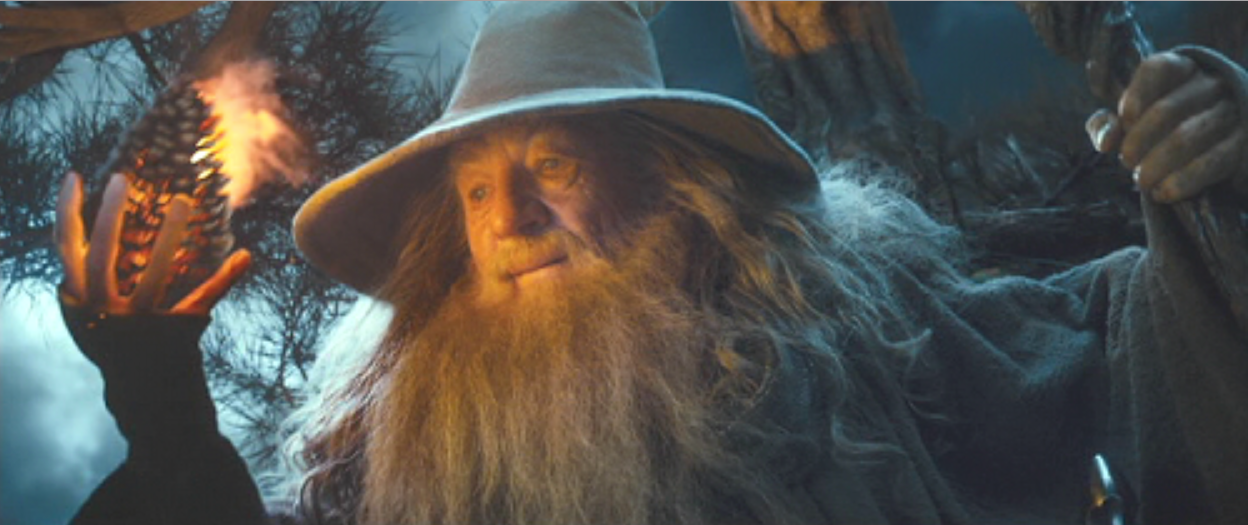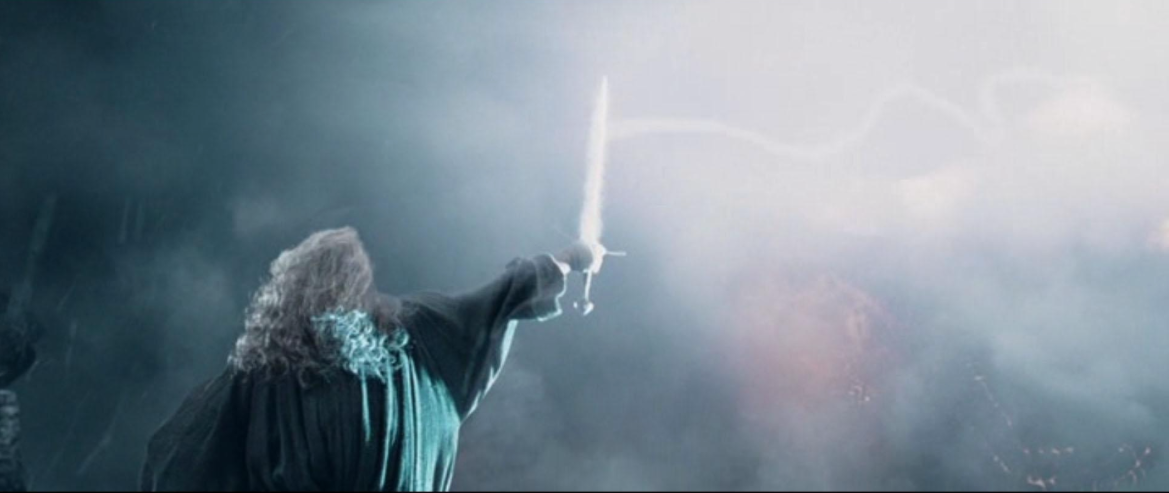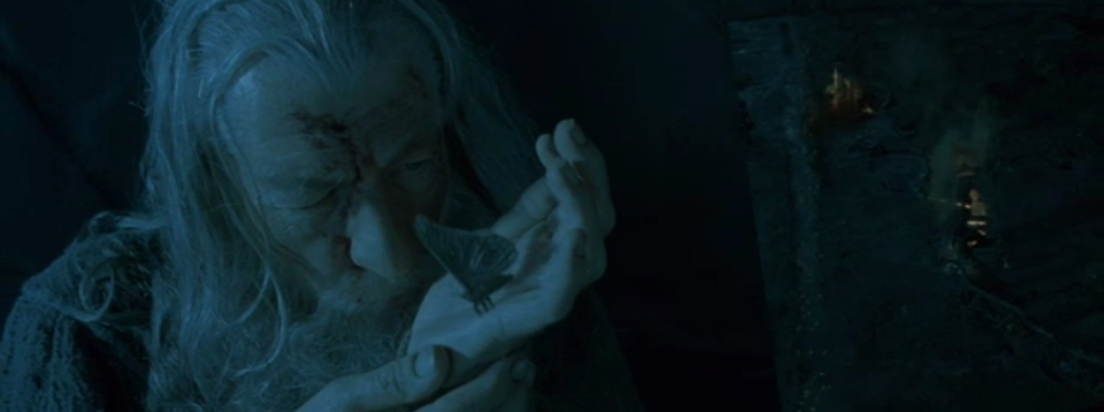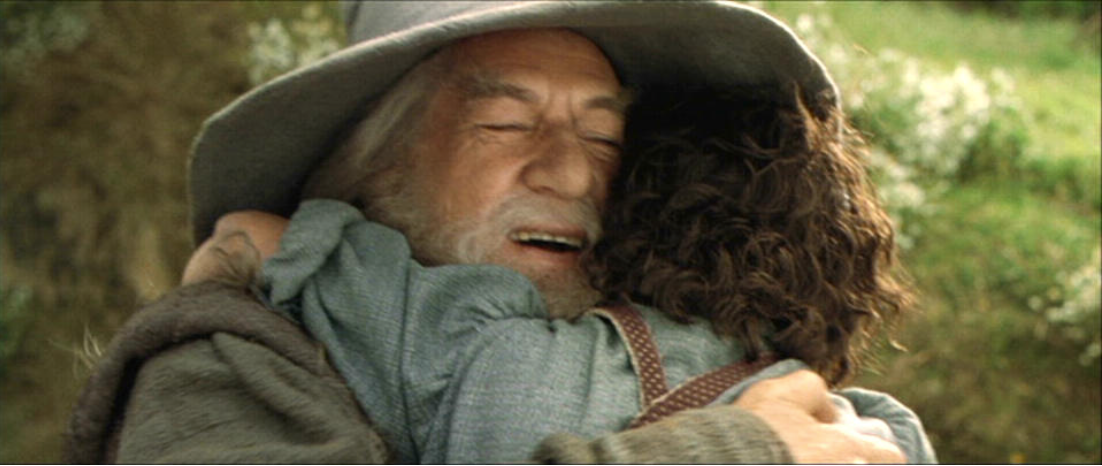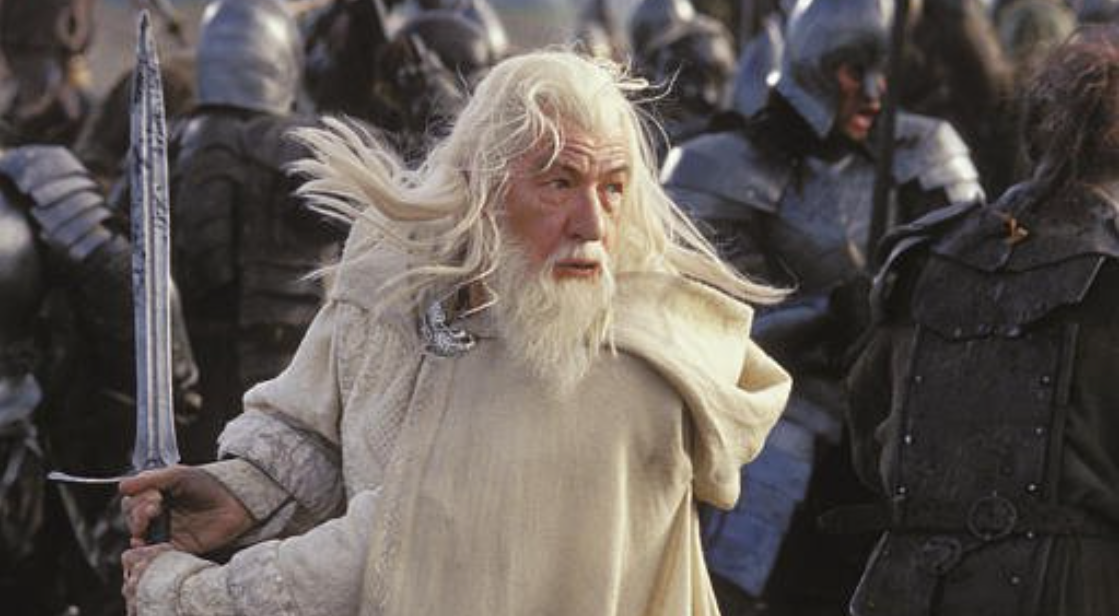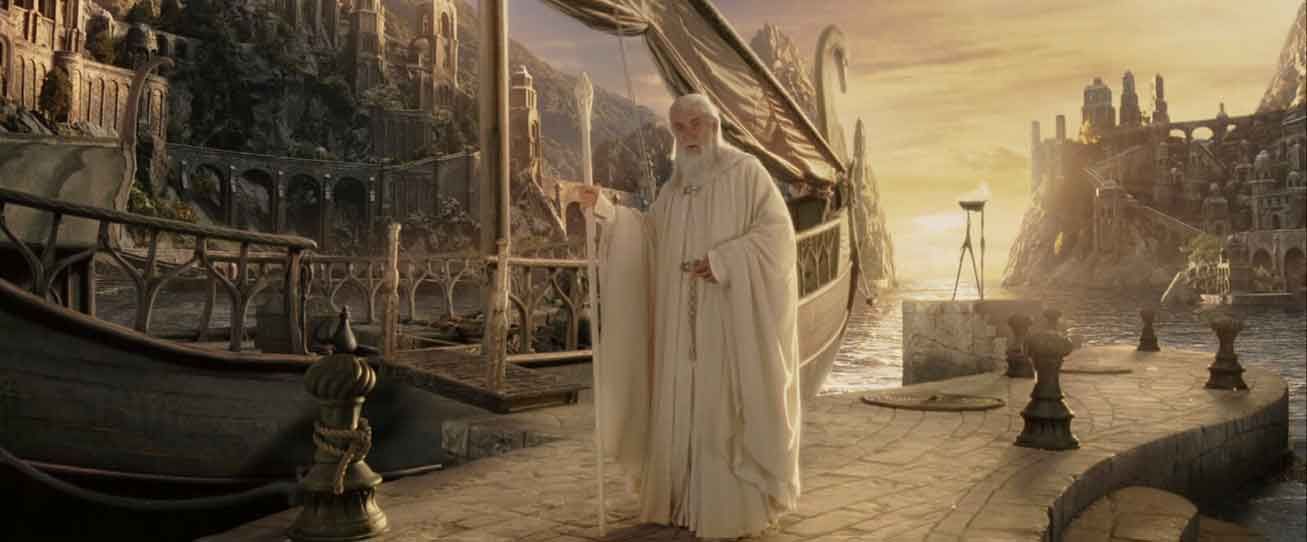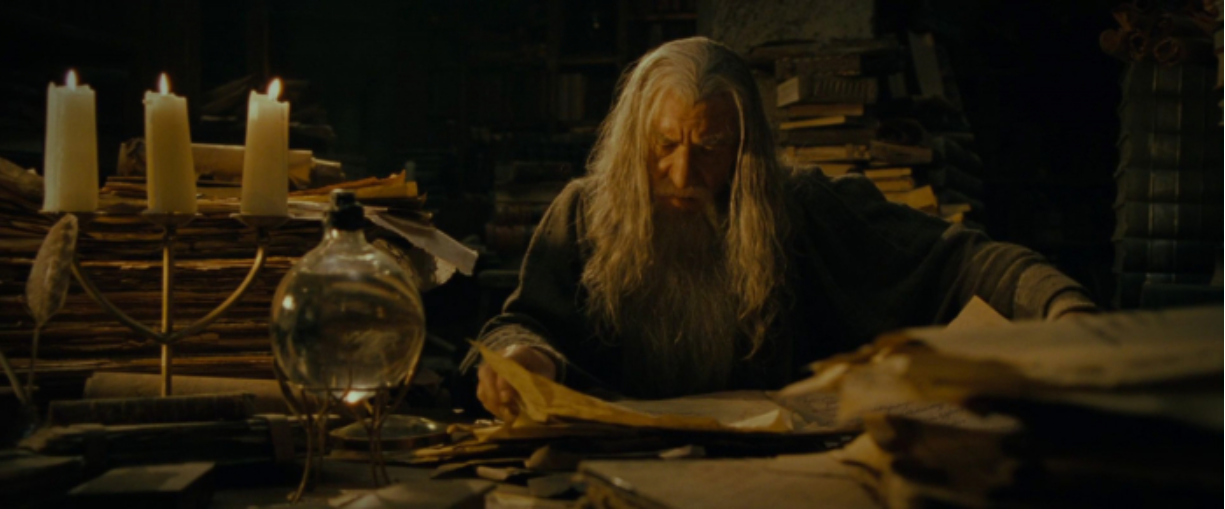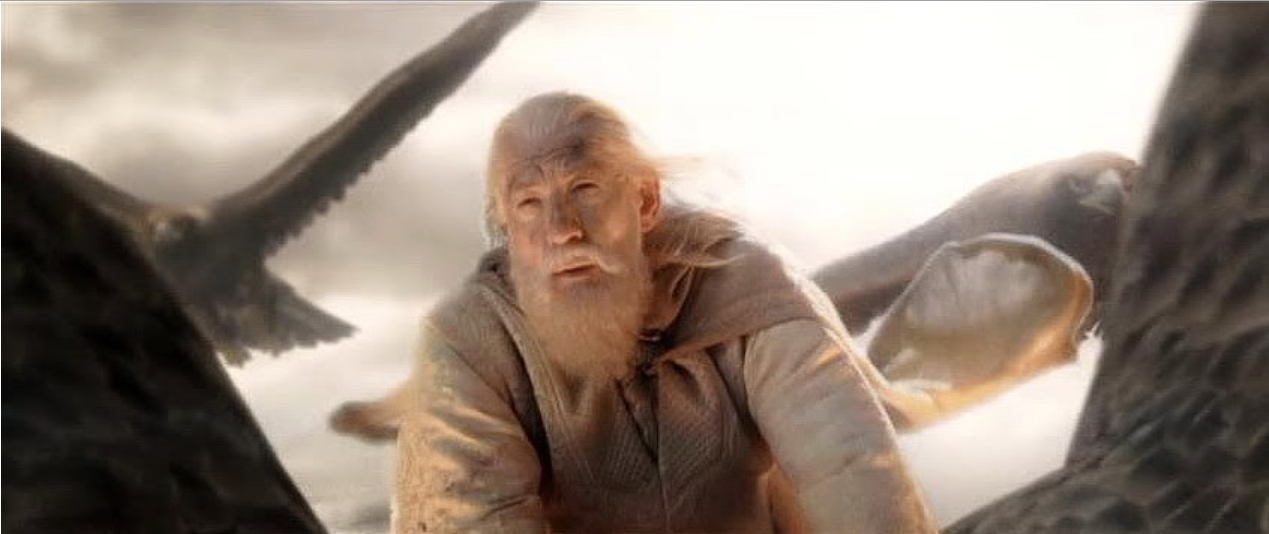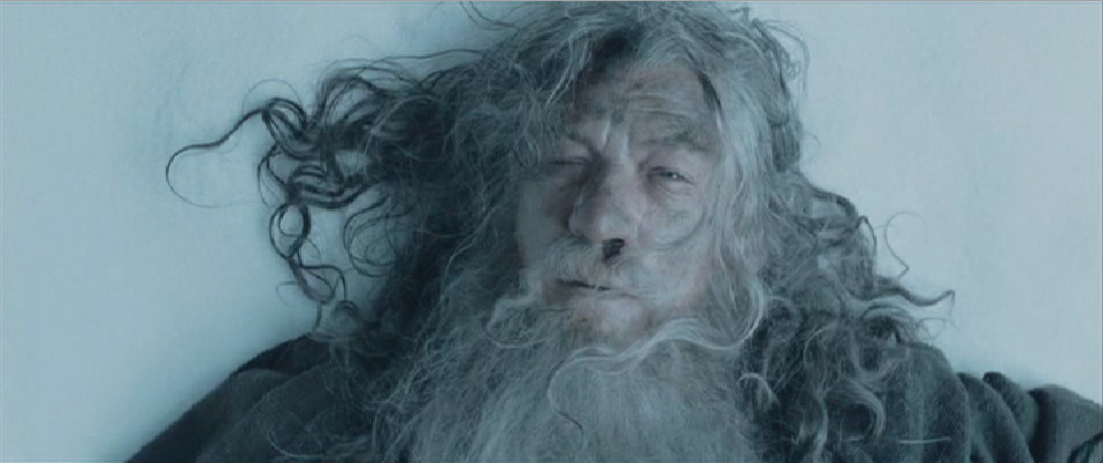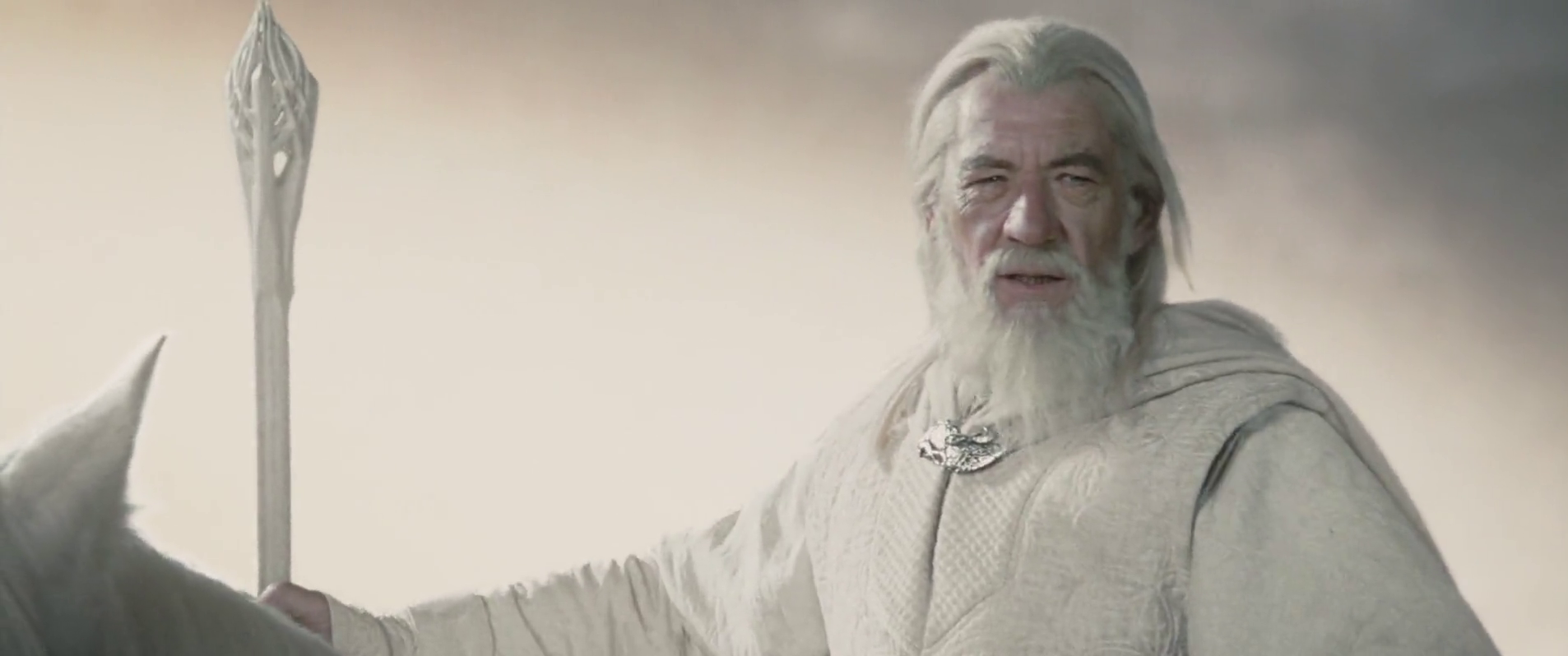The world of J.R.R Tolkien's Lord of the Rings is full of mystery, magic and a lot of luscious hair, and perhaps no other character fulfils those three things more than our favorite forgetful wizard, Gandalf. He may have no memory of certain places in Middle-Earth, but he's undoubtedly one of the most memorable characters in the series, from his infinitely quotable "YOU SHALL NOT PASS!" stand-off against the Balrog to riding into the battle of Helm's Deep when all hope seemed lost. But, while both of Peter Jackson's film trilogies -- The Lord of the Rings and The Hobbit series -- deliver plenty of great Gandalf action, they tell us very little of who he really is.
The film adaptations allow us to see the character only through the eyes of those around him. On the surface, he seems to be little more than a very old human man who wields incredible magical powers. In The Fellowship of the Ring, he reprimands a terrified Bilbo: "Do not take me for some conjurer of cheap tricks!" While he was just trying to intimidate the deceitful hobbit, he was also hinting at his true power -- which, for those not well-versed in their Tolkien lore, is shockingly immense. In fact, almost everything he presents to the outside world -- including his appearance and his own name -- are basically smoke and mirrors. In his "true" form, he's capable of some very weird and powerful things.
20 HE'S (KIND OF) AN ANGEL
Okay, Gandalf isn't an angel in the religious sense we think of them in, but he certainly has all the hallmarks of one. The man we know as Gandalf the Grey/White is actually a Maia, ancient spirits who existed before the creation of Arda (Tolkien speak for the creation of Earth). Diving back even farther into LOTR history, there are even more parallels with theological creation myths. In Tolkien's Legendarium, the divine, fatherly creator known as Eru brings the entire universe, Ea, into being simply by commanding it to exist: "Be!" Eru made Elves, Men and the Ainur (angelic beings) with his own hands.
He then delegated the shaping of Arda to the Ainur. Not all Ainur were made equal -- the best of the bunch were the Valar, who made all the big decisions while the comparatively weaker Maiar were left in a middle-management position. Each of the Valar preside over a different element with an appointed Maia at their side. Gandalf, or Olorin as he was originally named, belonged to Manwe the Wind-King and Varda the Star-Queen. Maia can speak many ancient and holy languages (including the Black Speech inscribed on the One Ring) and are "tall, wise, fair and powerful" beings. Gandalf isn't the only Maiar we're familiar with, either: Saruman, Radagast and Sauron are also his kin.
19 HE HAS A RING OF POWER
We can see just how alluring the One Ring is in The Fellowship of the Ring when even Gandalf is tempted to take it for himself. Little does Frodo know that Gandalf already has one Ring of Power: Narya, the Ring of Fire. Unlike the simple gold band that the One Ring takes the form of, Narya is an elegant piece of jewellery with a ruby set in the center. It was one of the three rings made originally for the Elves, forged by the Nolodorin prince Celebrimbor in the Second Age. Narya is distinctive from the other rings that have largely corrupting influences as it inspires the courage to stand against evil in others, as well as shielding the wearer against the ravages of time.
LOTR's "Appendix B: The Tale of Years" explains that the ring was entrusted to Gandalf by Cirdan, the Elvish lieutenant to the High King of the Noldor, Gil-galad, who created the Last Alliance of Elves and Men to stand against Sauron's forces. Gil-galad passed the ring to Cirdan before his death and when Gandalf touched down in Middle-Earth, Cirdan recognized that the angelic spirit could make better use of it than he. Gandalf's ownership of Narya explains how he still had the stamina to jump into battle at his old age, as well as how he manages to make allies despite facing such insurmountable odds.
18 HE CAN SHAPESHIFT
Over the course of LOTR, we witness Gandalf evolve, like a mystical Pokemon, from a grey-haired and grey-costumed old man to a white-haired and white-costumed old man. As glorious as his Super Saiyan form is, it's actually a pretty low key transformation for him. Gandalf wasn't born to be the spitting image of Sir Ian McKellan, his real form -- as a Maia -- is formless. They are spirits, after all. Both Maiar and the more powerful, Valar, can change their appearances at will.
Gandalf actually spent a period of time wandering around Middle-Earth in an "uncertain" form before he took the one we recognize as Magneto in a wig.
His new look was decided on when the Valar gave him a job to do: help the Free Peoples of Middle-Earth stand against Sauron. Gandalf became one of the Istari, five Maiar who became known as Wizards. The other four are Saruman (the White Wizard) Radagast (the Brown Wizard) and Alatar and Pallando (the Blue Wizards.) The ability to change shape at will can actually be taken from them if the power is "spent in hate and mockery," as Sauron infamously does. His punishment was to be forever stuck in the form of the Dark Lord, which isn't that punishing considering how cool he looks. Their formlessness also makes them near impossible to truly kill.
17 HE'S THOUSANDS OF YEARS OLD
In case being born before the creation of Earth wasn't enough of a clue, Gandalf is very, very, very old. That's really saying something too in a world inhabited by a lot of very old things. We get a sense of Gandalf's elongated lifespan from his depth of knowledge and number of acquaintances -- he seems to be Middle-Earth's resident busybody. There's also a clue in the fact he doesn't appear to age at all between the events of The Hobbit and LOTR. (We know that gap is about 60 years because Bilbo celebrates his 111th birthday at the start of The Fellowship of the Ring and he was around 50 years-old when Gandalf persuaded him to join Thorin's crew in The Hobbit.)
As a Maia, Gandalf is immortal. Not immortal in the way that vampires are perceived to be immortal in comparison to human lifespans -- Gandalf's immortality is legit. So, how old is he? Well, the Maiar were created by Eru -- the "God" of Tolkien's universe -- before the creation of Arda (Earth). There's not much to go on here in terms of dates because time wasn't really a thing yet in that primordial age. All we know for certain is that about 9,000 years passed until Gandalf was sent to Middle-Earth, which was about 2,000 years until the start of the events in LOTR. That makes him 11,000 years-old at least, likely much older.
16 HE HAS SUPERHUMAN STAMINA
Gandalf's possession of Narya, the Ring of Fire, gives him superior endurance to counteract the effects of ageing in his human form, which might explain how he's able to hold his own so valiantly in battle alongside men half his superficial age. It might also have given him a boost during his fatal clash with a Balrog in the Mines of Moria in The Fellowship of the Ring. After Saruman made it impossible for the Fellowship to pass through Mount Caradhras, Gandalf led them underground instead, a "dark and secret way" through the long-abandoned Dwarven mines.
Balrogs are essentially "fallen" Maiar (like Sauron) who were corrupted by Melkor -- the first Dark Lord, father of all Orcs and the root of all evil in the world. That makes Balrogs incredibly old and equally as powerful as Gandalf, evident in his struggle against this one, known as Durin's Bane. After both of them plummeted from the Bridge of Khazad-dum, they fell into an abyss leading to a freezing lake. From there, Gandalf chased the Balrog through some ancient tunnels until they reached the Endless Stair and climbed up to Durin's Tower, high above the clouds. It was there that Gandalf finally claimed victory before collapsing, dead. From the Bridge to their deaths, the whole battle lasted for over a week.
15 HIS VOICE HAS POWER
We're familiar with the idea of magic-users uttering special words to use spells but Tolkien used this idea a little differently. Gandalf and his fellow wizards used what are described as, "words of Command," which are a little tricky to explain because Tolkien fans are divided on how to interpret them. Some believe it's merely a fancy way to describe a spell, while others think there's more to it. There are a few examples of Gandalf invoking this skill in LOTR books, one of the most impressive being to fight off a group of "demonic wolves" sent by Sauron in "A Journey to the Dark."
"Gandalf seemed to suddenly grow: he rose up, a great menacing shape [...] "Naur an edraith ammen! Naur dan i ngaurhoth!" he cried. There was a roar and a crackle, and the tree above him burst into a leaf and bloom of blinding flame. The fire leapt from tree-top to tree-top. [...] The last arrow of Legolas kindled in the air as it flew, and plunged burning into the heart of a great wolf-chieften." Aside from pyromancy, he also uses this power to shatter Saruman's staff and strip him of his divinity. Some Tolkien-ophiles think that the words parallel the Biblical use of them, invoking the authority of God. As a Maia, Gandalf represents the authority of the Valar on Middle-Earth. Therefore, speaking a word of Command doesn't channel magic, it channels divine power.
14 HE GOES BY SEVERAL NAMES
It's not that surprising that someone who is thousands of years old has a nickname or two... or four... or seven. Okay, try 12. We may know him as Gandalf the Grey, and later Gandalf the White, but there are 11 others that he answers to. His original Maiar name is Olorin, in Quenya (an Elvish language spoken by the Valar) it means "dream." Upon arriving in Middle-Earth as part of the Istari order, he took human form, received his Ring of Power and adopted the name Gandalf. In Mannish, Gandalf literally translates to "Elf of the wand" or "Wand-elf," probably because his inability to age meant he was mistaken for an Elf, despite taking the appearance of a Man.
Over his two thousand years worth of travelling in Middle-Earth, he earned different titles from different groups of people.
The Elves and the residents of Gondor called him Mithrandir, a Sindarin (Elvish) name meaning "grey pilgrim." The Dwarves knew him as Tharkun, meaning "staff man." (Typical Dwarves...) His travels in the southern land of Harad earned him the name, Incanus, the meaning of which Tolkien never decided on. His enemies have called him Old Greybeard, Lathspell and Stormcrow, the latter implying that whenever Gandalf is around, bad news follows him. His other lesser-used nicknames are: Gandalf Greyhame and Gandalf the Wandering Wizard.
13 HE'S TELEPATHIC AND TELEKINETIC
In Tolkien's world, magic has less to do with pointing a wand made of unicorn hair and dragon cheeks and yelling fake latin as it does in Harry Potter, and more to do with a connection to the world around you. In LOTR, wizards were distinguished by their strong connection to nature, as Tolkien took inspiration from Pagan druids and old English and Celtic folklore, rather than our common pop cultural understanding of wizards and witches. Gandalf and his fellow Istari have influence over nature and people, and their strength comes from their willpower, not from the power of incantations or potions.
Gandalf's voice is one of his strongest assets but he can also demonstrate great power without uttering a single sound. In "The Pyre of Denethor," he disarms his adversary with a wave of his hand like a Jedi. "He lifted up his hand, and in the very stroke, the sword of Denethor flew up and left his grasp and fell behind him in the shadows of the house; and Denethor stepped backward before Gandalf as one amazed." Gandalf also displays some Professor X skills in "Many Meetings," when he pokes around Frodo's head. "You have talked long in your sleep, Frodo," said Gandalf gently, "and it has not been hard for me to read your mind and memory."
12 HE CAN CREATE SMOKE, FIRE AND LIGHTNING
The Ainur, the angelic beings that Gandalf belongs to, have a close relationship to light and heat, perhaps because of their divine status. They're immune to the hottest temperatures imaginable, which is probably why the Eye of Sauron, who is also an Ainur, looks like a ring of fire, and explains how he was able to forge the One Ring in the scolding lava of Mount Doom without dying. It also explains how Gandalf managed to win his fight against the fiery Balrog without being burnt to a crisp. Gandalf can also use this resistance to create heat, as well as defend from it.
Undoubtedly the most awesome of Gandalf's pyrokinetic powers is his ability to turn that fire into lightning.
In The Hobbit, he turns some pinecones into smoking grenades against a pack of wolves, and even alternates the temperature of each one between red, blue and green flames -- that's heat ranging from 327 to 1,3000 Celsius. Tolkien describes it as being "a most horrible and uncanny fire," and the implication that Gandalf's fire is unnatural is strengthened in LOTR when he ignites a spark on a wet log when the rest of the Fellowship fail to get a campfire going. Undoubtedly the most awesome of Gandalf's pyrokinetic powers is his ability to turn that fire into lightning, which he uses to smite some unlucky goblins in The Hobbit: "When the goblins came to grab him, there was a terrific flash like lightning in a cave, a smell like gunpowder, and several of them fell dead."
11 HE CAN SHOOT LIGHT AND PROJECT ENERGY
As well as the ability to produce and weaponize flames and smoke, Gandalf can use light for offensive purposes too. He uses this skill most prominently during "The Siege of Gondor" to ward off a swarm of Nazgul. "Like thunder they broke upon the enemy on either flank of the retreat; but one rider outran them all, swift as the wind in the grass: Shadowfax bore him, shining, unveiled once more, a light starting from his upraised hand. The Nazgul screeched and swept away, for their captain was not yet come to challenge the white fire of his foe." Usually, his energy projection is far more subtle than this, though.
During his tussles with other magically-empowered creatures in the films, like the Balrog and Saruman, you can see him absorbing and deflecting hits and even creating a glowing barrier to shield himself. As his mission on Middle-Earth is to aid the Free Peoples rather than secure a victory by himself, he usually restrains from using the full force of his powers on non-magical folk. Unless they really tick him off, like Wormtongue does in "The White Trees of Gondor." "In the gloom they heard the hiss of Wormtongue's voice: 'Did I not counsel you, Lord, to forbid his staff. That fool, Hama, has betrayed us!' There was a flash as if lightning had cloven the roof. Then all was silent. Wormtongue was sprawled on his face."
10 HE CAN TALK TO ANIMALS
Gandalf can create fireworks, spark heat from nowhere, shoot giant beams of light at flying demons and battle Balrogs to the ends of the Earth. It's easy to forget some of his less flashy skills amongst all that, like communicating with animals. Gandalf's relationship with nature doesn't run as deep as his fellow Istari, Radagast, but he's still able to read the elements, manipulate them and chit-chat with creatures who are lower on the food chain. He's able to call Shadowfax, the "lord of all horses," to his side with just a thought, and Gandalf is the only person with explicit consent to ride him.
In The Fellowship of the Ring film adaptation, Gandalf uses a giant silk moth to send an S.O.S after he becomes trapped on top of Orthanc by the deceitful Saruman. The moth returns with Gwaihir, one of the Great Eagles, who helps Gandalf escape from his former friend. The moth doesn't appear in the books, and many fans believe it was inserted into the films to replace Radagast -- or even that it was Radagast in disguise. It also makes a cameo at the end of The Hobbit: An Unexpected Journey, fluttering in front of Gandalf's face just before the Great Eagles show up to rescue Thorin's company from Azog and the Orcs. Gwaihir himself is actually capable of speech, so Gandalf doesn't need any special skills to strike up a conversation with him.
9 HE LEARNED PITY AND COMPASSION
"Pity" and "compassion" might seem like odd things to claim as skills, but remember -- Gandalf isn't a normal, mortal man, he's an ancient angelic being who existed long before Middle-Earth and all the lives on it. Immortality often goes hand-in-hand with indifference, or worse: a total lack of sympathy for "lesser" creatures. Some of Gandalf's fellow Maiar have either sought violent domination of the Free Peoples of Middle-Earth, like Sauron and Saruman, or have been generally apathetic to getting involved at all, like Radagast. Gandalf, however, succeeded in his mission because he learnt to empathize with the people he was sent to save.
All Maiar are taken under the wing of one or two Valar teachers -- the greater of the two forms of Ainur. Gandalf, or Olorin as he was named then, belonged to Manwe the Wind-King and Yavanna the Star-Queen, but it was arguably Queen Nienna, the "Lady of Mercy" that had the most lasting influence on him. Nienna was ostensibly a figure of perpetual mourning, but her lesson to Gandalf was that grief should strengthen rather than weaken you; her tears spilt over the Dark Lord Melkor's destructive acts created the Sun and Moon. Gandalf's capacity for compassion is his most under-appreciated gift, and as Nienna's greatest student, he wore grey to honor her teachings.
8 HE HAS AN ANCIENT ELVEN SWORD
Gandalf's signature weapon his is staff, which he uses both to funnel his magic through and as a walking stick. His other weapon is his trusty sword, Glamdring, which translates to "foe-hammer" in Quenya. Gandalf happened upon the blade during The Hobbit when he and Thorin's company ventured into into a Troll's cave and discovered a stash of loot. Gandalf wielded the weapon to fatal effect against the Great Goblin, while Bilbo found Sting, which he'd later pass on to Frodo, and Thorin picked up Orcrist.
All great fantasy weapons have names and histories like living beings, and Glamdring is no exception.
The sword dates back 6,000 years in LOTR history, all the way back to the First Age when it was forged by the King of Gondolin, Turgon, the first and last ruler of the hidden Elven kingdom, and great-grandfather to Elrond. Turgon had the sword in hand when he clashed with Morgath (the evil Valar formerly known as Melkor) during the Battle of Unnumbered Tears. Gondolin fell and the sword passed into legend until it found a new home at Gandalf's side. Like all powerful Elven weapons, Glamdring can warn its bearer of incoming evil, and it also had a rune inscription across the hilt, which in the film version reads: "Turgon, King of Gondolin, wields, has and holds the sword Glamdring, Foe of Morgoth's realm, Hammer of Orcs."
7 HE NEVER REALLY DIES
Gandalf appears to "die" twice over the course of LOTR. The first time is for real after he slays the Balrog following their intense, drawn-out brawl. By that point, the old Wizard probably just saw it as taking a nap for all of eternity after the longest working week of his life. Gandalf's physical body dies but his true, incorporeal form lives on. Being a Maiar, his mortal body was just a skin suit to allow him to pass undetected in Middle-Earth, and his mind/spirit was able to live on: "Then, darkness took me, and I stayed out of thought and time, and I wondered far on roads that I will not tell."
Gandalf's resurrection is really just the growth of a new "vessel" for his immortal spirit, and a promotion from Grey to White, helped in part by Saruman's treachery leaving the position open. (When the great Eagle Gwaihir rescues him he notes that Gandalf's new body weighs almost nothing.) Even at the end of the trilogy when he hops on the ship with Frodo, Elrond and Galadriel, Gandalf isn't going to what we would think of as the afterlife -- the Undying Lands are his home, the place where Ainur come from. Gandalf and all other immortals will likely continue living until the prophesied Dagor Dagorath: the end times.
6 HE CLAIMS TO WEILD THE POWER OF THE SUN
We have to say "claims" here because there's no real evidence of this other than Gandalf boasting about it. When Gandalf faces Durin's Bane, the awakened Balrog of the Mines of Moria on the Bridge of Khazad-dum, he does so knowing a drawn-out battle is on the cards -- one he probably isn't sure he'll win. In order to give the Fellowship time to make a hasty exist, Gandalf stands his ground. Before he delivers his famous, "YOU SHALL NOT...PASS!" line, he tries to intimidate the beast by rattling off some of his claims to fame, including: "I am a servant of the Secret Fire, wielder of the flame of Anor!"
The "flame of Anor" isn't mentioned anywhere else so it's hard to know what the Grey Wizard was talking about here. Some speculate that he was referring to Narya, the Ring of Power in his possession that is tied to fire. Others reckon he was calling out his allegiance to the Valar, enemies of the Balrog, and the "Secret Fire" is said to burn "at the heart of the world." To back this up, "Anor" is the Elvish word for "sun," and in Tolkien's creation myth, the sun was nurtured to life by the tears of Gandalf's teacher, Queen Nienna of the Valar. We do also see him shining an intensely bright light on the Balrog from his staff in the film. Is that the "flame" he means?
5 HIS GREATEST POWER IS HIS WISDOM
Wizards are typically characterized as being scholarly men who dispense wisdom to the ears of kings and other significant people, like Merlin to King Arthur. Gandalf certainly follows that tradition. Over the course of The Hobbit and LOTR, Gandalf offers sage advice -- or, interference, as his detractors might describe it -- to rulers and would-be rulers. Tolkien's preponderance with Old English spellings and Faerie folklore means that he probably wanted readers to think of this kind of magical learnedness as being less about casting spells and brewing potions, and more about reading signs in nature and amassing knowledge of the world.
Gandalf's brand of magic is tied to the druidic, pagan kind, that classes things like reading the stars, superstitions and having a bond with the natural world as forms of wizardry. Time and time again, we see the mental library that Gandalf has spent thousands of years in Middle-Earth cultivating help himself and his allies out of a tight spot. Without his knowledge, the One Ring would never have been found and destroyed. That's also how he came to be so highly respected, someone who people will listen to. The Silmarillion even describes him as the "wisest of the Maiar," so even among his peers his wisdom was superior.
4 THE EAGLES ARE INDEBTED TO HIM
One of the most controversial parts of Tolkien's work is his inclusion of some great, big deus ex machina birds. The Great Eagles are descended from Thorondor, the "Eagle Lord," the biggest Eagle that ever lived, with a wingspan of 180 feet. Their leader, Gwaihir is the one who carries Gandalf out of the jams he sometimes finds himself in, as well as the one who saved Frodo from becoming a burnt marshmallow on the side of Mount Doom. During LOTR, Gwaihir resumes Gandalf twice from harms way, the first time from the top of Orthanc where Saruman had him imprisoned, and the second time from the Endless Stair after Gandalf's resurrection.
Though the Great Eagles pitch in where needed in the fight against evil, they're not Middle-Earth's Uber stand-in.
In order to call in favours, Gandalf paid his fare in advance by saving Gwaihir from a poisoned arrow once. The controversy around the Eagles pertains to a perceived plot hole: why didn't they just fly the One Ring to Mount Doom? The simple answer is that massive flying things are easy targets. The Tolkien answer is that it would be boring. "The Eagles are a dangerous 'machine,'" he wrote in response to a fan's query on the matter. "I have used them sparingly."
3 HIS MISSION KEEPS HIM ALIVE
We've already established that Gandalf's immorality and (secretly) incorporeal form means it's impossible for him to completely disappear from existence. After his dramatic battle against the Balrog ends his life as Gandalf the Grey, his consciousness drifts around aimlessly for days. Gandalf might have continued drifting without form for the rest of his life had something not pulled him back to a new body. In "The White Rider," several days after the death of Gandalf the Grey, Gandalf the White was born. "Naked I was sent back -- for a brief time, until my task is done."
The meaning implied in "until my task is done" is that Gandalf's mission prevented him from never returning to the physical plane. He was tasked with what you could describe as a "holy" quest by the Valar to help the Free Peoples of Middle-Earth defeat Sauron and his forces, so it's possible that either his own willpower and commitment to that calling aided his rebirth, or perhaps the Valar themselves had a hand in it. Some fans even think that Eru, the divine creator of everything in Tolkien's universe, was responsible. (One thing he couldn't manifest, however, were clothes -- his new white robes were given to him by Galadriel after Gwaihir rescued him.)
2 HE CAN TOTALLY BEAT THE WITCH KING
Another controversial element of LOTR comes from the film adaptations. In Return of the King, Gandalf comes face to face with the feared Witch King of Angmar mounted on a Nazgul. The Witch King's sword bursts into flame and a high-pitched noise crackles through the air between the adversaries; shattering Gandalf's staff. Gandalf is thrown from a startled Shadowfax and lies at the Nazgul's feet. Suddenly, the Witch King's attention is drawn elsewhere and he flies off. Not only is it a bit cheap to ramp up to a fight and then do the whole "distraction" trick, but hardcore Tolkien fans bemoaned Gandalf appearing to be the lesser of the two as it was unfaithful to the source material.
They're absolutely right, too. What do we know about Gandalf? He's an immortal, angelic spirit who has lived since the dawn of time; he has a vast knowledge of magic; he can manipulate the elements; he's slain a Balrog and defeated Saruman (fellow Maiar) and as Gandalf the White, he's stronger than ever. The Witch King, on the other hand, is a corrupted Man who draws all of his power from Sauron. Plus, in the book's version of things, Gandalf is the only one at Minas Tirith able to resist the Witch King. Though Gandalf does admit that the Witch King could defeat him if Sauron lends him enough strength, Gandalf is clearly the naturally superior being.
1 HE'S LIMITED ONLY BY HIS MISSION
Speaking of possible plot holes and deus ex machina devices, if Gandalf is so powerful, then why isn't he able to defeat Sauron himself? Given that he and Sauron are both Maiar, you'd think the Valar would have sent Gandalf and his fellow Istari to directly put down one of their own in a way that Men and Elves and other mortal beings can't. Instead, Gandalf's mission is to observe, guide and support the Free Peoples, not stand alone as a smiting, divine force from the heavens. Other than the obvious answer that this would make for a less interesting story, there's a practical reason too.
Gandalf's mission restrains his phenomenal powers because the Valar don't want to lay waste to Arda (Earth) with a huge, cosmic battle.
They want to preserve Middle-Earth from the ravages of war as much as possible. The idea is to snuff Sauron out like a candle, not burn everything down in the process. That's why we only ever witness Gandalf going "all out" against enemies who are on his level -- like the Balrog -- and when there's little or no chance of collateral damage. He does get a major power boost when he becomes Gandalf the White, but even then, he's still operating with the safety on.

